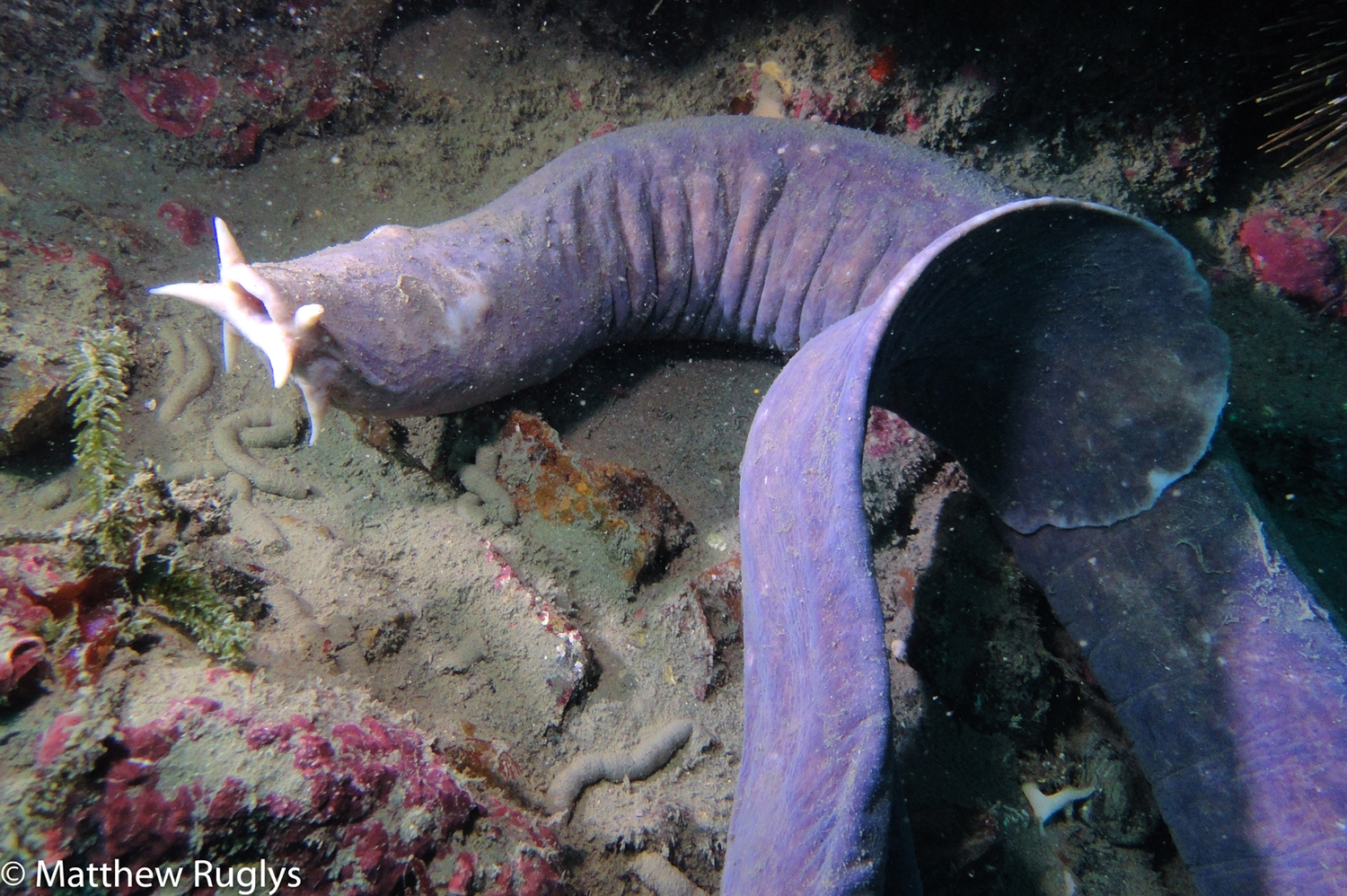- Classification
- MYXINI
- MYXINIFORMES
- MYXINIDAE
- Eptatretus
- cirrhatus
Broadgilled Hagfish, Eptatretus cirrhatus (Forster 1801)

A Broadgilled Hagfish, Eptatretus cirrhatus, in Island Bay, Wellington, New Zealand, May 2019. Source: mattruglys / iNaturalist.org. License: CC By Attribution-NonCommercial
A pinkish-grey hagfish with a cylindrical body, a paddle-like tail and six barbels around the circular mouth. Some individuals may have a piebald coloration.
Broadgilled Hagfish are scavengers, feeding mostly on dead and dying invertebrates, fishes, and the odd dead marine mammal that has sunk to the seafloor. They also prey on live fishes - rasping through the flesh with their rows of sharp teeth.
Hagfishes are renowned for their ability to produce copious amounts of slime when threatened. The slime, exuded from pores along the body, expands enormously on contact with sea-water.
Video footage from New Zealand shows hagfish slime clogging the mouth and gills of predators.
Broadgilled Hagfish, Eptatretus cirrhatus (Forster 1801)
More Info
|
Distribution |
Found in temperate continental shelf and slope waters of Australia from off the southern part of the Great Barrier Reef, Queensland to off eastern Tasmania. Broadgilled Hagfish live on soft bottoms in depths of 100-760 m in Australia. The species is also widespread in coastal, shelf, and slope waters of New Zealand in 1-922 m. |
|
Features |
Anterior unicusps 8–10; Posterior unicusps 8–10; Total cusps 44–51; Prebranchial pores 16–20; Branchial pores 5–7; Tail pores 10-14; Total pores 79-87. |
|
Size |
To 83 cm. |
|
Colour |
In preservative: Overall light to dark brown with irregular pale spots and patches, ventral and caudal finfolds occasionally with whitish margins; tip of the barbels white; mouth and gill apertures with white margins. |
|
Feeding |
Hagfishes scavenge on dead or dying marine life, usually on fishes and invertebrates. They also scavenge on marine mammals that have sunk to the ocean floor. They feed by rasping flesh with their horny teeth, often going completely inside sunken carcasses and feeding from the inside out. |
|
Biology |
The sexes are either separate, or individuals can be hermaphrodites, possessing both male and female reproductive tissue. One large female contained about 50 large eggs when examined. |
|
Fisheries |
Many specimens in Australia have been collected in baited traps. A fishery harvesting the Broadgilled Hagfish has been operating in New Zealand waters since 2007. |
|
Conservation |
IUCN Red List: Least Concern http://www.iucnredlist.org/apps/redlist/details/154825/0 |
|
Species Citation |
Petromyzon cirrhatus Forster in Bloch & Schneider 1801, Systema Ichthyologiae: 532. Type data: Neotype NMNZ Breaksea Sound, Fiordland, New Zealand |
|
Author |
Bray, D.J. 2018 |
|
Resources |
Broadgilled Hagfish, Eptatretus cirrhatus (Forster 1801)
References
Fernholm, B. 1998. Hagfish systematics, pp. 33–44. In: Jørgensen, J.M., Lomholt, J.P., Weber, R.E. & Malte, H. (eds). The Biology of Hagfishes. London: Chapman & Hall.
Fernholm, B. & Paxton, J.R. 1998. Hagfishes, pp. 1192. In: Carpenter, K E. & Niem, V H. (eds). FAO Species Identification Guide for Fishery Purposes, The Living Marine Resources of the Western Central Pacific. Rome: FAO.
Forster, J.R. in Bloch, M.E. & Schneider, J.G. 1801. Systema Ichthyologiae Iconibus ex Illustratum. Berlin. 584 pp. 110 pls
Gomon, M.F. & M. Mincarone. 2008. Myxinidae, In: Gomon, M.F., D.J. Bray & R.H. Kuiter (eds.) Fishes of Australia's southern coast. Reed New Holland & Museum Victoria.
Martini FH, Beulig A (2013) Morphometics and Gonadal Development of the Hagfish Eptatretus cirrhatus in New Zealand. PLoS ONE 8(11): e78740. DOI: 10.1371/journal.pone.0078740
May, J.L. & Maxwell, J.G.H. 1986. Field Guide to Trawl Fish from Temperate Waters of Australia. Hobart : CSIRO Division of Marine Research 492 pp.
McMillan, C.B. & Wisner, R.L. 1984. Three new species of seven-gilled hagfishes (Myxinidae, Eptatretus) from the Pacific Ocean. Proceedings of the California Academy of Sciences 43(16): 249-267.
McMillan, P.J., M.P. Francis, G.D. James, L.J. Paul, P.J Marriott, E. Mackay, B.A. Wood, L.H. Griggs, H. Sui & F. Wei. 2011. New Zealand fishes. Volume 1: A field guide to common species caught by bottom and midwater fishing. New Zealand Aquatic Environment and Biodiversity Report No. 68. 329 p.
Minarcone, M.M. 2009. Eptatretus cirrhatus. In: IUCN 2011. IUCN Red List of Threatened Species. Version 2011.1. http://www.iucnredlist.org/apps/redlist/details/154825/0
Mincarone, M.M. & Fernholm, B. 2010. Review of the Australian hagfishes with description of two new species of Eptatretus (Myxinidae). Journal of Fish Biology 77: 779-801.
Mincarone, M.M. & Stewart, A.L. 2006. A new species of giant seven-gilled hagfish (Myxinidae: Eptatretus) from New Zealand. Copeia 2: 225-229.
Patzner, R.A. 1998. Gonads and reproduction in hagfishes, pp. 378-395. In: J.M. Jørgensen, J.P. Lomholt, R.E. Weber, & H. Malte (eds). The biology of hagfishes. Chapman & Hall, London.
Scott, T.D., Glover, C.J.M. & Southcott, R.V. 1974. The Marine and Freshwater Fishes of South Australia. Adelaide : Government Printer 392 pp. figs.
Whitley, G.P. 1940. The Fishes of Australia. Part 1. The sharks, rays, devil-fish, and other primitive fishes of Australia and New Zealand. Sydney : Roy. Zool. Soc. N.S.W. 280 pp. 303 figs.
Zintzen, V., Roberts, C.D., Shepherd, L., Stewart, A.L., Struthers, C.D., Anderson, M.J., McVeagh, M., Noren, M. & Fernholm, B. (2015) Review and phylogeny of the New Zealand hagfishes (Myxiniformes: Myxinidae), with a description of three new species. Zoological Journal of the Linnean Society 174: 363–393. doi: 10.1111/zoj.12239 Abstract
Zintzen V, KM Rogers, CD Roberts, AL Stewart, MJ Anderson. (2013) Hagfish feeding habits along a depth gradient inferred from stable isotopes. Marine Ecology Progress Series 485:223-234. Abstract







